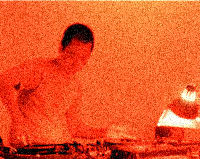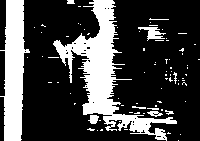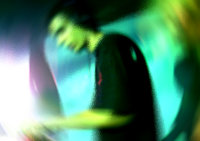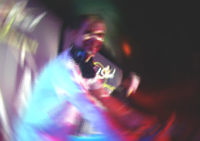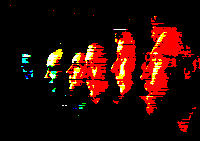

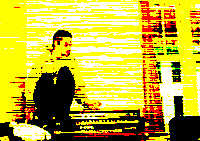 Bonobo
|
SonarTextBy Paul D. Miller a.k.a. Dj Spooky that Subliminal Kidwww.djspooky.com
Sonar is one of the largest festivals of electronic music in Europe. Aside from the U.S.'s "Burning Man" Festival that occurs in August, it''s one of the main places that international dj culture can explore the outter limits of mix culture. But that's an understatement. To put it bluntly: it's THE festival that determines the taste and style of the currents of electronic that flow through the world's underground and avant-garde music in the early 21st century. As such, it brings together the major themes and issues that undergird digital media, sound art, and contemporary aesthetics - it's a perfect reflection of what's going on in the rapidly changing world of digital culture. Paul D. Miller a.k.a. Dj Spooky that Subliminal Kid, one of 21C Magazine's editors, was involved with the production of the catalog that went with the festival, and we have the pleasure to reproduce a remix of one of the main essays that went with the text that accompanied Sonar. The people who run the festival asked Paul D. Miller to write a playful homage to this years Sonar as the main catalog essay for the book that accompanied the show, and here's a revised and expanded version of his text with images. "Sonartext" is an intimate view of the mentality that accompanies the idea of a modern avant-garde festival - it's a manifesto statement about the digital NOW. cd>dir>>goto>> the text begins here> First, as always - a series of invocations:
"There was no book of the forest,
Handwriting occurred on waves, A gradual acceptance of this new language." Michael Ondaatje "Handwriting"
"...New Babylon will first be realized by its inhabitants"
Manifesto for a New Babylon
Anthony Braxton "Strategies of Composition" 1993
Is it live? Or is it a sample? Is it an algorithm or a sequence? What are the codes written in the invisible sounds of the electronic here and now? The permutations of the questions cue up like an old familiar track on a record that we all know, a sound at the edge of the collective imagination. The rest as the button says is basically for you to press "play." Flash animate the situation. Check the wildstylz. Sonar. Like any street corner intersection in the city, you have to always look in every direction, and that's what makes this kind of electronic music just as fun to create to as to listen to. That's one of the core issues for me for the festival. How to balance between all of the new impulses electronic music has unleashed in us. Whether its "electro" retro-1980's techno, hip-hop, drum n bass, or whatever title you want to call it, the basic sense is of total theater. Think of Wagner's "gesmakunstwerk" mixed with, oh, I don't know, Basement Jaxx's "Where's Your Head at" that was directed by TRAKTOR or the Avalanche's Kuntz & Macguire directed "Frontier Psychiatry" - check the vibe: pop culture staged as a freak show, cracked up musicians from the planet of the apes, every musical element on the stage of the theater of the mind gets its proper musical meaning - the patients entire analytic scene lies open: a nightmare come to the surface. Think of the circumstances: we all use software, we all use programming. What changes the mixes are the cultural conditions each person brings to the situation. What Guy Debord called the "dérive" you flip and take out the é and get: drive. Or even better, think of it in the same way that Gaudi used surface elements for his architecture of the unconscious in Barcelona. The impulses are the same. The format is what's different. Use your eyes to hear and your ears to see - check the rhythm reality. Basically, its a new way of doing something that's been with us as humans for a long time: creating with found objects. The rotation gets thick. The constraints get thin. The mix breaks free of the old associations. New contexts form from old. The script gets flipped. The languages evolve and learn to speak in new forms, new thoughts: the sound of thought becomes legible again at the edge of the new meanings. After all, you have to learn a new syntax but the modus operandi remains the same... Think of it as an inheritance from Charles Babbage's "Difference engine" - but alot more fun. With no specific hardware to weigh you down, the mix becomes open ended - a new kind of magic opens up the situation to all sorts of interpretations in that liminal space between physical and non-material space - music is how we interpret the process - the graphic interface of urban culture translated into digital environment. Sonar. Sound Text. skip/transition/code 404>>
Soundlab - an event in NYC or a template for festival culture in the age of the invisible machine. It's all about the "Happening." Sonic rotationŠ. Geographic dislocationŠ Think of Duchamps "roto-reliefs" mixed with Thelonius Monk's "Notes From Undergound" and flip 'em both through the Dostoyevsky novel with the same title, and you'll get a drift of what I'm talking about here. Sound. Invisible. Transient. Patterns in the air. Think of it as a new way of engaging electronic culture with what Amiri Baraka called the "changing same." Take the idea and fold it in on itself. Think of it as laptop jazz, cybernetic jazz, nu-bop, illbient... a nameless, formless, shapeless concept given structure by the rhythms, and that's a good start. Optometry: it's a new way of thinking about something that's in all of our lives every day: patterns, codes, ciphers... whatever angle you look at it from, it's all about speaking with the invisible and letting the conversation become total media, total text. The end result: optometry. Gesamkunstwerk or "total art" becomes source code for the context. The soundtrack floats away and leaves the film altogether. Sound and image divorce and re-configure before they re-unite in the mix. Please think of that when you listen to the sounds. The wheels turn, the discs spin, the hard drives flow with the recursive logic of the tyranny of the
beat - the times change, and the music evolves. It's a stream of consciousness thing. But at the end of the day, its all about the changing same, the core of repetition at modern thought that Duke Ellington liked to put as a question: "who is playing in the shadow of whom?" It's the 21st century. Afro-Eurasian eclipse meets nu-bop in the streets of the remixed city. A list of ancestors: Bud Powell, Fats Waller, Duke Ellington, The New York Art Ensemble, Erik Satie, Morton Feldman, Alan Kay, Douglas Englebart, Vannevar Bush.... the litany is long, and could go on forever. But that's kind of the point. The samples and fragments speak the unspoken, the ascent remains unbroken. Nu-bop, nu-forms, nu-soundz: flip the script, open the equation, check the situation. Guy Debord used to call this style "detournement," Freud called the "uncanny" - we call it "wildstyle." We call it carnival. We call it parade. And it's a way of life that's here to stay. It was all about situations then, and its like that now, only a little more entrenched. Is it live? Or is it a sample? After almost three decades of rhythm science, the question remains just as powerful as ever. The Uncanny remains with us. Charlie Parker and Charlie Patton played notes from an underground that were about content rather than context. The music of the invisible machine comes to us from the software of the day. MAX/MSP, TRAKTOR, SUPERCOLLIDER, NATO 55, REASON, REBIRTH, RECYCLE, MIXMANŠ the names go on, but the picture emerges. Software is infinite. Sonar is about the reflection of sound to ground us in an electronic environment. Think of bats flying in the night. Navigate the metaphor, cut and paste it into the here and now. Commedia del arte becomes digital, becomes total theater, becomes electro-acoustic. Feel the frequencies. Sonar 2002.
|
